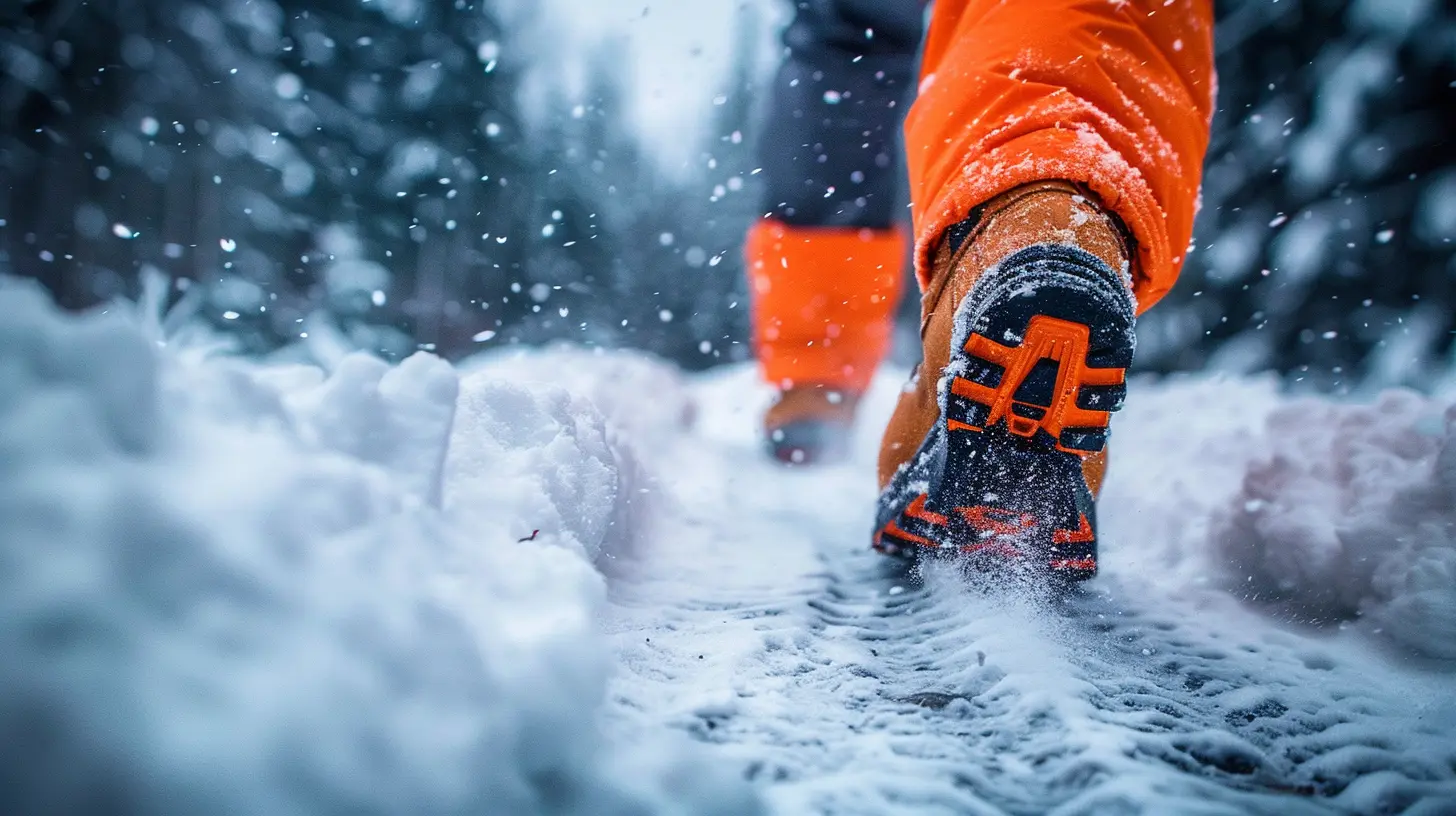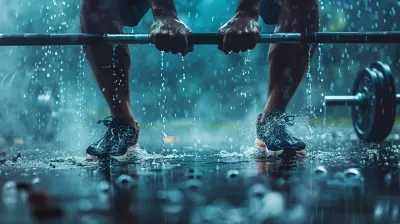Preventing Injuries While Training in Extreme Conditions
15 January 2025
Training under extreme conditions can push your body to new heights, but it also comes with serious risks. Whether you're running in scorching heat, lifting weights in freezing temperatures, or hiking up a mountain through a storm, the environment can throw more challenges at you than just the physical demands of your workout. Injuries are common, and if you're not careful, that intense training session can turn into a painful setback.
So, how can you push your limits while staying safe? Let’s dive into the best practices for preventing injuries when training in extreme conditions.

Understand The Risks
First things first, you need to understand what you're up against. Extreme conditions can vary, and so do the risks associated with them. You wouldn’t train the same way in 100°F heat as you would in sub-zero temperatures. Each environment presents unique challenges to your body, and you need to adjust your approach accordingly.Heat-Related Risks
Training in high temperatures can lead to dehydration, heat exhaustion, and even heatstroke. Your body loses fluids rapidly through sweat, and if you're not replenishing them, your performance will decline, and injury risks will skyrocket. Overheating can also lead to muscle cramps, dizziness, and fainting—none of which are conducive to a good workout (or safety, for that matter).Cold-Related Risks
On the other hand, frigid conditions pose their own threats. Cold weather restricts blood flow, which makes your muscles stiffer and more prone to injury. You’re more likely to pull or strain a muscle when your body is cold, and frostbite or hypothermia can become a real danger if you're not properly dressed.Altitude & Terrain Challenges
Extreme conditions aren’t just about temperature. Training at high altitudes or on rugged terrains introduces new variables. At high altitudes, the reduced oxygen levels can take a toll on your endurance, and unfamiliar or difficult terrains can lead to sprained ankles, twisted knees, or falls.The key takeaway? You need to respect the environment you're training in because the conditions aren’t just a backdrop—they're an active part of the challenge.

Hydration Is Non-Negotiable
No matter what extreme condition you're training in, hydration is your best friend.Why Hydration Matters
Your body is made up of about 60% water, and it needs that hydration to function properly. When you're sweating buckets in the heat, or even when you’re working out in the cold, you’re losing fluids. Dehydration doesn’t just lead to fatigue—it makes you more injury-prone. Without enough water, your muscles are less elastic, your joints are less lubricated, and your body’s ability to regulate its temperature is compromised.How to Hydrate
Don’t wait until you're thirsty to drink water. By the time you feel thirsty, you're already dehydrated. Instead, sip water throughout your workout and make hydration part of your pre-and post-workout routine. For longer sessions or workouts in extreme heat, consider electrolyte drinks to replace the salts and minerals you're losing through sweat.Pro Tip: Keep an eye on the color of your urine. If it’s dark yellow, that’s a sign you need more water. Aim for a light, straw-like color to know you're well-hydrated.

Warm-Up And Cool Down - Yes, Even In Extreme Conditions
Warming up and cooling down are essential parts of any workout, but they become even more critical in extreme conditions. Skipping these steps in the cold or heat is like trying to run a marathon without lacing up your shoes—you're setting yourself up for failure.Warm-Up In The Cold
In colder conditions, your muscles are tighter and less flexible. A proper warm-up will gradually increase your body temperature and get your blood flowing to your muscles, making them more pliable and less prone to injury. A good warm-up should last at least 10-15 minutes and involve dynamic stretches like leg swings, arm circles, and light jogging.Warm-Up In The Heat
In hotter conditions, your body may already feel warm, but that doesn’t mean you're ready to jump into high-intensity training. A warm-up increases your heart rate and prepares your muscles for the demands you're about to place on them. Start with low-intensity movements and gradually ramp up so your body transitions smoothly into your main workout.Cool Down Is Equally Important
After your workout, cooling down is just as important to help your heart rate return to normal and to reduce muscle stiffness. In cold weather, the cooldown can prevent sudden muscle tightness as your body temperature drops. In hot weather, it helps bring down your core temperature gradually, avoiding dizziness or fainting.
Dress For Success
What you wear during your training can make or break your workout, especially in extreme conditions.Cold Weather Gear
In cold weather, layering is key. But don’t just throw on any old sweater—your clothing should be moisture-wicking to keep sweat away from your skin. Start with a base layer that wicks away moisture, add an insulating layer to keep you warm, and top it off with a windproof or waterproof jacket if the conditions call for it.Also, make sure you cover exposed skin. Your head, hands, and feet lose heat the quickest, so hats, gloves, and thermal socks are a must.
Hot Weather Gear
In the heat, opt for lightweight, breathable fabrics that allow sweat to evaporate and keep you cool. Look for moisture-wicking materials here as well, but focus on lighter colors that reflect the sun’s heat rather than absorbing it. And don’t forget sunscreen—sunburns can lead to dehydration and increase your risk of overheating.Pro Tip: Avoid cotton in extreme conditions. Cotton holds onto moisture and will leave you feeling wet and uncomfortable, which can lead to chafing or worse, hypothermia in cold weather.
Be Mindful Of Your Body’s Signals
Your body is constantly talking to you, and in extreme conditions, you need to listen more closely.Know The Early Signs of Trouble
In the heat, watch out for signs of heat exhaustion: dizziness, headaches, nausea, and an elevated heart rate. If you feel any of these symptoms, stop your workout immediately, find shade, and rehydrate.In cold conditions, be mindful of numbness or tingling in your fingers, toes, or face—these can be early signs of frostbite. If you start shivering uncontrollably or feel disoriented, you may be experiencing hypothermia, and it's time to get somewhere warm fast.
The bottom line? Don’t try to tough it out. Your body knows when something is wrong, and it’s better to cut a workout short than risk a serious injury or illness.
Don’t Skip Rest Days
Yes, it's tempting to keep pushing, especially when you're training for a specific goal, but overtraining can lead to injuries, especially when you're already dealing with extreme environmental factors. Rest days are your body's time to recover, repair muscle tissue, and adapt to the stress you've put it through.Importance of Recovery
Skipping rest days doesn’t just wear you down physically—it also affects your mental focus. And when you're training in extreme conditions, mental sharpness is crucial. Fatigue can lead to poor decision-making, which is a fast track to injury.Make sure you get enough sleep, eat a well-balanced diet, and take time to stretch or do low-intensity activities like walking or yoga on your rest days.
Adjust Your Expectations
One of the most important things to remember when training in extreme conditions is that you might not be able to perform at your peak—and that’s okay. Extreme heat, cold, or altitude can significantly impact your endurance, strength, and speed. Adjust your goals and be realistic about what your body can handle in these environments.Focus on Effort, Not Outcome
Instead of focusing on hitting a specific time or lifting a certain weight, focus on the effort you're putting in. If you're giving it your all in extreme conditions, that's a win in itself. You don’t need to set a personal best every time you train—sometimes staying injury-free and consistent is the best outcome.
Conclusion
Training in extreme conditions can be incredibly rewarding, but it also comes with challenges that can lead to injury if you're not careful. By understanding the risks, staying hydrated, wearing the right gear, warming up and cooling down, listening to your body, and giving yourself adequate time to rest, you can push your limits safely.Remember, it's not just about training harder—it's about training smarter. Respect the environment you're in, and you'll set yourself up for long-term success without the setbacks of injury.
all images in this post were generated using AI tools
Category:
Injury PreventionAuthor:

Umberto Flores
Discussion
rate this article
21 comments
Kingston McKellar
Great insights on injury prevention in extreme training! Emphasizing preparation and hydration is essential for athlete safety and performance.
April 4, 2025 at 8:07 PM

Umberto Flores
Thank you! I'm glad you found the insights valuable. Preparation and hydration are indeed crucial for safe and effective training in extreme conditions.
Capri Sanders
Preventing injuries in extreme conditions? Just remember: if your training plan includes dodging flying penguins or running through a hailstorm of tacos, it might be time to rethink your goals! Safety first, folks—save the extreme for your weekend Netflix binge!
February 13, 2025 at 5:01 AM

Umberto Flores
Great point! While extreme training can be fun, prioritizing safety is essential. Let’s keep our goals realistic and our training smart!
Wade Love
Training in extreme conditions is like walking a tightrope—one misstep can lead to injuries. A smart mix of preparation, hydration, and listening to your body can keep you in the game and out of the doctor's office. Stay sharp, stay safe!
February 4, 2025 at 7:58 PM

Umberto Flores
Thank you for highlighting the importance of preparation and self-awareness in extreme training! Staying vigilant is key to injury prevention.
Veronica Thomas
Prioritize safety over intensity.
February 1, 2025 at 8:05 PM

Umberto Flores
Absolutely! Safety should always come first to ensure long-term health and performance.
Indigo Bishop
To prevent injuries in extreme conditions, stay hydrated, acclimatize gradually, wear appropriate gear, listen to your body, and prioritize recovery. Safety first for effective training!
January 28, 2025 at 11:46 AM

Umberto Flores
Thank you for your insightful tips! Staying safe and listening to our bodies are crucial for effective training in extreme conditions.
Kova Vance
Training in extreme conditions demands a strategic approach to injury prevention. Athletes should prioritize proper hydration, gradual acclimatization, and listen to their bodies. Incorporating cross-training and flexibility exercises can enhance resilience. Ultimately, balancing intensity with recovery is crucial to ensure long-term performance and safety in challenging environments.
January 24, 2025 at 1:15 PM

Umberto Flores
Thank you for highlighting the importance of a strategic approach to injury prevention in extreme conditions. Your points on hydration, acclimatization, and the balance between intensity and recovery are essential for athlete safety and performance.
Noemi Wheeler
This article effectively highlights essential strategies for preventing injuries during extreme training conditions. Emphasizing proper hydration, gradual acclimatization, and appropriate gear, it provides valuable insights for athletes. Implementing these practices can significantly enhance performance while minimizing the risk of injuries in challenging environments.
January 23, 2025 at 5:32 AM

Umberto Flores
Thank you for your thoughtful comment! I'm glad you found the strategies helpful for enhancing performance and preventing injuries. Your insights on hydration and gear are spot on!
Zethryn Holland
Oh sure, because training in extreme conditions without injuries is just a walk in the park!
January 21, 2025 at 5:34 AM

Umberto Flores
Absolutely, it's a challenge, but with the right strategies and preparation, it's possible to minimize risks and train effectively!
Eden Larsen
Stay smart and hydrate, friends! Embrace the challenge of extreme training while listening to your body. With a little care, you’ll conquer those conditions and thrive!
January 21, 2025 at 3:47 AM

Umberto Flores
Thank you for the reminder! Listening to our bodies is crucial for injury prevention and effective training in extreme conditions. Stay safe!
Ximena Ross
This article offers valuable insights on injury prevention in extreme training conditions. It emphasizes the importance of proper preparation and listening to one’s body, providing a balanced perspective that could benefit both seasoned athletes and newcomers alike.
January 20, 2025 at 12:20 PM

Umberto Flores
Thank you for your feedback! I'm glad you found the insights valuable for both seasoned athletes and newcomers. Proper preparation and body awareness are indeed key to injury prevention.
Vex Cook
This article is a crucial reminder of the importance of safety in extreme training conditions. Each athlete's well-being should always come first. By following these guidelines, we not only enhance performance but also protect our bodies for the long journey ahead. Thank you for shedding light on this vital topic!
January 20, 2025 at 5:19 AM

Umberto Flores
Thank you for your insightful comment! I’m glad you found the article helpful in highlighting the importance of safety in extreme training. Prioritizing athlete well-being is essential for long-term success.
Samuel McAdoo
In nature's fierce embrace we train, Balance strength and caution's reign— Safety whispers, "Stay aware.
January 19, 2025 at 8:14 PM

Umberto Flores
Thank you! Emphasizing awareness and balance is key to training safely in extreme conditions.
Zinnia Benton
Train smart, stay hydrated, and let’s keep our limbs intact! 🏃♂️💪🌧️
January 19, 2025 at 11:44 AM

Umberto Flores
Absolutely! Staying mindful and hydrated is key to injury prevention—let's stay safe out there! 💧🏃♂️
Remi McGrath
Training in extreme conditions requires vigilance. Prioritize hydration, wear appropriate gear, and listen to your body. Gradually acclimate to the environment to minimize injury risk. Stay safe!
January 18, 2025 at 8:20 PM

Umberto Flores
Absolutely! Vigilance, hydration, proper gear, and acclimatization are key to ensuring safety during extreme training. Thank you for highlighting these essential points!
Emory Larsen
In the pursuit of greatness, athletes must remember that resilience does not equate to disregard for their bodies. Prioritizing safety in extreme conditions is essential not just for performance but for longevity in sport.
January 18, 2025 at 3:52 AM

Umberto Flores
Absolutely agree! Prioritizing safety ensures not only peak performance but also a sustainable athletic career. Resilience should always be balanced with care for our bodies.
Jett Carrillo
Great article! It's crucial to focus on injury prevention while training in extreme conditions. Proper hydration, suitable gear, and listening to your body can make all the difference in staying healthy and achieving your goals.
January 17, 2025 at 9:43 PM

Umberto Flores
Thank you! I completely agree—prioritizing hydration, appropriate gear, and body awareness is essential for safe training in extreme conditions. Your insights are spot on!
Sorin Taylor
Stay safe, train smart! 😊
January 16, 2025 at 9:41 PM

Umberto Flores
Thank you! Staying safe and training smart is essential for injury prevention. 😊
Felicity Mathews
Training in extreme conditions can be tough, but remember—every challenge you face builds resilience and strength! Prioritize safety and listen to your body. By taking the right precautions, you'll not only prevent injuries but also emerge stronger and more prepared for whatever comes your way. Keep pushing forward!
January 16, 2025 at 5:15 AM

Umberto Flores
Thank you for your insightful comment! Prioritizing safety and resilience is key to successful training in extreme conditions. Appreciating the balance between challenge and care is essential for long-term strength and preparedness. Keep pushing safely!
Zina Meyers
Effective injury prevention in extreme training requires proper hydration, tailored warm-ups, and mindful pacing to ensure athlete safety and performance.
January 15, 2025 at 9:00 PM

Umberto Flores
Thank you for highlighting these crucial factors! Proper hydration, tailored warm-ups, and mindful pacing are indeed essential for promoting athlete safety and optimizing performance in extreme training conditions.
Lincoln Carr
Adaptability and recovery are key to injury prevention.
January 15, 2025 at 1:47 PM

Umberto Flores
Absolutely! Emphasizing adaptability and recovery is essential for reducing injury risk, especially when training in extreme conditions.
Cambria Carey
Great insights! It’s so important to prioritize safety during intense training. Small adjustments can make a big difference in preventing injuries.
January 15, 2025 at 4:18 AM

Umberto Flores
Thank you! I completely agree—safety must always come first, especially in challenging training environments. Small changes can indeed lead to safer practices.
MORE POSTS

Vegan and Vegetarian Nutrition for Athletes: Hitting Your Protein Goals

Building a Strong Core for Long-Term Injury Prevention

When Legends Fall: Scandals That Shattered Athlete Legacies

How Smart Surfaces Are Enhancing Performance in Sports Arenas

How Club Teams Balance Tradition with Innovation

The Importance of Pre-Game Rituals in Hockey Performance

The Science Behind Muscle Recovery: What You Need to Know

A Guide to Golf Tournaments and Formats

The Rivalry That Electrified the NBA: Warriors vs. Cavaliers
Formula 1’s Iconic Rivalries: Senna vs. Prost

The Most Memorable Upsets in Grand Slam Tennis History

The Essential Guide to Energy Gels: Are They Right for Your Sport?
When Heroes Fall: The Dark Side of Sports Icons